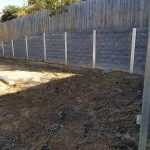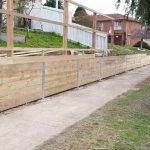Introduction
In the realm of building and landscaping, keeping walls play an important function in managing soil erosion, boosting aesthetics, and offering structural support. But what goes into constructing these essential structures? That's where the knowledge of skilled retaining wall builders comes into play. Whether you're http://daltonfencing-contractorsazld414.iamarrows.com/the-advantages-of-working-with-a-regional-retaining-wall-contractor looking for a retaining wall installer, a retaining wall contractor, or merely curious about the materials utilized like concrete sleepers, H beams, wood sleepers, timber sleepers, or stone, comprehending their engineering understanding is vital.
Understanding the Engineering Expertise of Competent Retaining Wall Builders
The process of constructing a keeping wall is more than simply stacking blocks or putting concrete. It involves a deep understanding of soil mechanics, hydrology, and structural engineering principles. Knowledgeable keeping wall home builders have not just experience however also an array of technical abilities that permit them to navigate the intricacies involved in this type of construction.
When you think about it, every job presents special difficulties. The site conditions can differ commonly-- varying from high slopes to loose soils-- and this variability requires tailored options. A qualified retaining wall builder examines these factors carefully to pick the ideal design and products. For example, when dealing with extensive clay soils that expand and contract based on moisture levels, particular methods should be used to prevent failure.
What Makes Keeping Walls Essential?
Retaining walls are basic for several factors:
Soil Disintegration Control: They assist stabilize slopes and avoid soil displacement. Creating Usable Land: By leveling land, they expand usable space for gardens or patios. Aesthetic Appeal: Beautifully developed walls can improve property value. Water Management: They can direct water flow away from structures.
These aspects highlight why employing a competent professional is crucial for making sure longevity and functionality.
Types of Retaining Walls
Gravity Walls
- These count on their weight to hold back soil. Typically made from concrete or stone.
Cantilevered Walls
- Utilize a lever arm developed to resist lateral pressure. Often constructed utilizing reinforced concrete.
Anchored Walls
- Use cable televisions anchored in the earth behind the wall. Highly efficient for high-pressure situations.
Modular Block Walls
- Made from interlocking blocks held together by gravity. Easy to install and maintain.
Sheet Pile Walls
- Consist of thin areas driven into the ground. Commonly used in soft soil conditions.
Materials Utilized in Retaining Wall Construction
Concrete Sleepers
Concrete sleepers are robust materials that use resilience and versatility in style. They're especially efficient for modern-day visual choices while needing minimal upkeep over time.
H Beams
H beams offer considerable strength for taller walls where there's significant lateral pressure from soil. Their industrial style typically provides itself well to modern landscapes.

Wood Sleepers & Timber Sleepers
Wood-based alternatives provide an environment-friendly option however require careful treatment versus rot and pests. Lumber uses natural charm but might require routine upkeep to ensure longevity.
Stone Retaining Walls
Stone walls stimulate a sense of timelessness and can blend flawlessly with natural landscapes. However, they frequently demand higher labor expenses due to their detailed installation processes.
The Function of Soil Mechanics in Building Retaining Walls
Understanding soil behavior is essential for any retaining wall builder. Soil types vary commonly-- sand drains quickly while clay keeps moisture-- and each type has different load-bearing capacities that affect how a wall will perform over time.
Why Do Various Soils Matter?
Clay soils can swell when damp, increasing pressure against walls. Sandy soils might move all of a sudden without proper drainage systems in place. Rocky surfaces might require customized devices for excavation or anchoring.An experienced specialist will conduct extensive site investigations, consisting of soil tests, before choosing specs for materials and designs.
Hydrology Issues in Retaining Wall Design
Water management directly affects stability; pooling water behind a wall develops hydrostatic pressure that can cause disastrous failures if not properly managed through drainage solutions like weep holes or French drains.
How Do Drainage Systems Work?
Weep holes allow excess water to escape. French drains pipes redirect water stream far from walls. Proper grading keeps water far from susceptible areas.Ignoring these elements could result in expensive repairs down the line!
Cost Considerations When Employing a Retaining Wall Builder
Building a retaining wall isn't practically selecting materials; it's also about budgeting effectively for both instant expenses and long-term maintenance expenses associated with different kinds of walls.
|Type|Typical Cost (per foot)|Durability|Upkeep Level|| --------------------|-------------------------|------------|-------------------|| Concrete Sleepers|$20 - $30|50+ years|Low|| H Beams|$25 - $35|40+ years|Medium|| Wood Sleepers|$15 - $25|15 - 30 years|High|| Stone|$30 - $50|100+ years|Low|

Investing sensibly ensures sturdiness without breaking the bank!
FAQ Section
What credentials need to I search for in a maintaining wall contractor?
Look for accreditations associated with construction management, as well as experience specific to keeping walls-- a portfolio showcasing previous projects helps too!
How do I identify which material is best for my project?
Consider elements such as area (soil type), desired aesthetics, spending plan restraints, and whether you choose low-maintenance alternatives over visual appeal.
What's associated with obtaining authorizations for developing keeping walls?
Local regulations differ; normally, you'll require strategies submitted by your specialist revealing compliance with zoning laws before approval is offered by city organizers or other authorities.
Can I build my own keeping wall?
While DIY jobs are possible, they need significant understanding about regional soils & & hydrology as well as engineering principles; mistakes can lead to pricey repairs later on on!
How long does it require to develop a keeping wall?
Depending on intricacy & & size-- expect anywhere from one weekend (for little modular tasks) approximately numerous weeks (for larger custom-made constructs).
Are there any ecological considerations when developing a maintaining wall?
Absolutely! Always ensure your project adheres to regional regulations concerning wildlife environments & & run-off control measures throughout building activities!
Conclusion
In summary, comprehending the engineering know-how of proficient retaining wall home builders is necessary whether you're planning your next home improvement job or simply want more insight into landscaping methods that safeguard your home investment! From acknowledging different types of products-- like concrete sleepers or stone-- to comprehending hydrological effects and cost considerations-- it all boils down to making notified decisions backed by expert understanding! So don't hesitate; seek advice from experts who bring years of experience in addition to innovative options tailored specifically toward accomplishing lasting results!